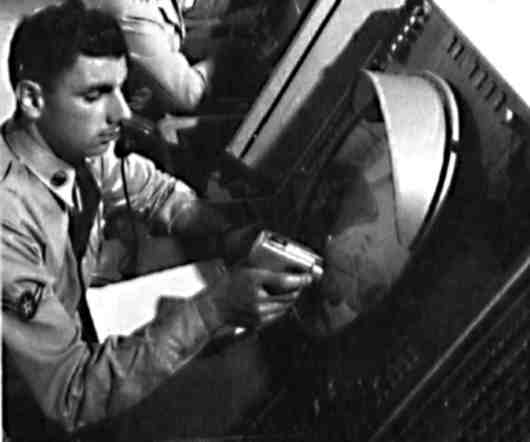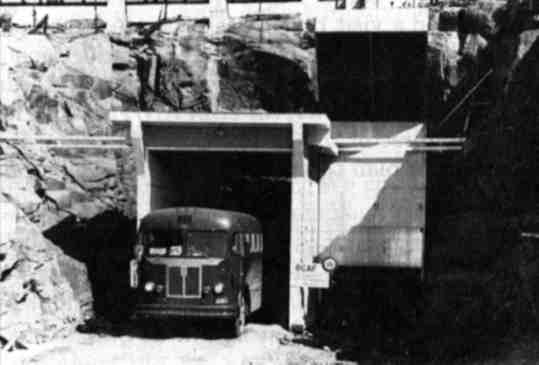| SAGE - Computer of the Cold War |
| Written by Historian | ||||||
Page 2 of 2
SAGE goes undergroundThe whole system eventually evolved into the SAGE - Semi-Automatic Ground Environment - system, a network of radar, computing and communication centers - each with its own Whirlwind computer center. The first such station became operational in 1957 and the system was completed in 1961 with three radar networks transmitting realtime data over standard phone lines. Of course, being a military installation and an important potential target for nuclear attack, the command centers needed to be protected. But how to protect a machine the size of a building and one that was still evolving? The first idea was to bury the whole thing underground. They started to dig the first Direction Center only to hit the water table. Test borings for the second site hit solid granite. From then on the Center grew upwards floor by floor. Others were buried in mountainsides and some were built like huge concrete block houses. All had their own dual generator sets, cooling plants and a single floor dedicated to the FSQ-70 computer - consisting of 70 frames of 60,000 valves. Each machine weighed 250 tons and needed a 3000 kilowatt power supply. The final version of the machine was a single address binary computer with a 32-bit word size. The core memory was 8192 words with a cycle time of 6 micro seconds (i.e. 0.17Mhz). In practice it managed a very respectable 75,000 32-bit operations per second. Another technique pioneered in the machine was the use of cycle stealing I/O channels - today we would probably call this DMA. Although it was a general purpose computer it did have some special features to enable it to work with x,y co-ordinates. Its registers could treat a single 32-bit word as a pair of 16-bit values - effectively doubling its throughput. A second level of storage was provided by twelve magnetic drums each holding around 12000 32-bit words. The drums were also used to buffer incoming data until it could be processed. The results of the processing were displayed on specially designed video consoles. These used large, 19 inch, Charactron tubes which allowed graphics and text to be mixed. The CRT tube contained a mask which held the shape of each of the characters. The beam was deflected to pass through one of the character shapes and then it was then steered to a specific screen location. There was also a small, 5-inch, text-only display used to give details such as weather and other background information. The operator could interact with the screen with a remarkable new device - a light gun. This was pointed at the screen and a trigger pulled to select a radar track. Once selected the operator could type in information that identified the type of track. Clearly the operator played an important role in processing the data and there is no suggestion that the SAGE system represented a fully automatic defence system. However to the casual user it looked as if the day of automatic war had arrived.
An operator uses a light gun to identify a track on the Charactron tube The SAGE system with its futuristic banks of interactive visual displays and huge machines buried under mountains did stir the imagination of the science fiction writers and film makers from Colossus to War Games - see side panel. In reality the achievement was impressive but the computer was a long way from being in control. Much of the processing was a matter of standard database operations but applied to data generated in real time. For example, consider the problem of separating the radar clutter from the real tracks. Radar clutter, i.e. all the reflections that do not correspond to real tracks would swamp the computer. How would you solve this problem? The modern approach would be to try to introduce some complex image processing technique to filter out the clutter. The SAGE team didn't resort to the full high tech but they did find a solution. The radar image was displayed on a PPI (Plan Position Indicator - i.e. a standard radar display) and a special paint coating was applied to cover up the stationary clutter. An operator actually painted out the coastline and any other regular reflections on the tube. A photocell was fitted to pick up the flashes that were not masked. The pulses from the photocell were used to gate the data being passed to the computer. A nice touch was the fact the paint stopped the transmission of the scanning spot but not the after glow of the phosphor which was a different colour. This allowed the operators to still see the image through the paint even though the data was not passed on to the computer. That way at least there was no possibility of the Russians sneaking up through the clutter! The full SAGE system used 24 FSQ-7 machines. The first Direction Center was deployed in 1958. The final Direction Center was opened in 1963. The last was closed down in 1983 - representing some of the oldest computers in use at the time.
Deep inside a mountain - the SAGE system at North Bay was one of the last to be turned off. A 6000 foot tunnel took the bus 600 feet underground to the three-storey 150,000 square foot building that houses the Direction Center.
The management structure that created it seems to have been very loose to say the least. Budgets were overrun without too much worry, engineers took implementation decisions without reference to a committee and a sense of urgency and national security drove the design teams. Further away from the Second World War, and with the management techniques of today, it is doubtful if 10% of the results could have been achieved with 200% of the resources! Some pictures used with the permission of The MITRE Corporation. Copyright © The MITRE Corporation. All Rights Reserved.
|
||||||
| Last Updated ( Friday, 29 November 2019 ) |



